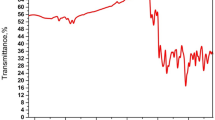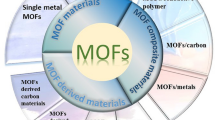Abstract
Porous carbon is one of the favorable materials for electrodes in supercapacitors owing to its huge particular area of the surface, high intensity, and stable characteristics of chemistry. The metal–organic framework [Zn (NH2-bdc) (4,4′-bpy)] was synthesized using the hydrothermal method. The porous carbon ZNBC-T-A was synthesized through the chemical activation of ZnCl2. Further, whether the micromorphology and electrochemical characteristics of porous carbon ZNBC-T-A are related to the carbonization temperature and ZnCl2 activator ratio was investigated. The results showed that the porous carbon ZNBC-700-1:3 had a hive-like architecture with a particular area of the surface of 2078 m2 g−1. The activator ZnCl2 entered the pores of the precursor as a template, which prevented the pores from collapsing. This template served as a template agent. When the current density was 1.0 A g−1, the porous carbon ZNBC-700-1:3 exhibited a specific capacitance of 210.6 F g−1. The retention of capacitance was 90.5% after 5000 repetitions, while coulomb efficiency was kept at nearly 100%.









Similar content being viewed by others
Data availability
All data generated or analyzed during this study are included in this article and available from the corresponding author on reasonable request.
References
W. Sun, Y. Zhang, Z. Yang, F. Yang, High-performance activated carbons for electrochemical double layer capacitors: effects of morphology and porous structures. Int. J. Energy Res. 44, 1930–1950 (2020)
H. Chen, L. Hu, Y. Yan, R. Che, M. Chen, L. Wu, One-step fabrication of ultrathin porous nickel hydroxide-manganese dioxide hybrid nanosheets for supercapacitor electrodes with excellent capacitive performance. Adv. Energy Mater. 3, 1636–1646 (2013)
R.R. Salunkhe, Y.V. Kaneti, Y. Yamauchi, Metal-organic framework-derived nanoporous metal oxides toward supercapacitor applications: progress and prospects. ACS Nano 11, 5293–5308 (2017)
C. Baslak, S. Demirel, A. Kocyigit, H. Alatli, M. Yildirim, Supercapacitor behaviors of carbon quantum dots by green synthesis method from tea fermented with kombucha. Mater. Sci. Semicond. Process. 147, 106738 (2022)
S. Dong, L. Wu, M. Xue, Z. Li, D. Xiao, C. Xu, L. Shen, X. Zhang, Conductive metal-organic framework for high energy sodium-ion hybrid capacitors. ACS Appl. Energy Mater. 4, 1568–1574 (2021)
M. Yu, D. Lin, H. Feng, Y. Zeng, Y. Tong, X. Lu, Boosting the energy density of carbon-based aqueous supercapacitors by optimizing the surface charge. Angew. Chem. Int. Ed. 56, 5454–5459 (2017)
W. Tian, H. Zhang, X. Duan, H. Sun, G. Shao, S. Wang, Porous carbons: structure-oriented design and versatile applications. Adv. Funct. Mater. 30, 1909265 (2020)
Z. Ma, H. Liu, Q. Lü, Porous biochar derived from tea saponin for supercapacitor electrode: effect of preparation technique. J. Energy Storage 40, 102773 (2021)
M.Y. Masoomi, A. Morsali, A. Dhakshinamoorthy, H. Garcia, Mixed-metal MOFs: unique opportunities in metal-organic framework (MOF) functionality and design. Angew. Chem. Int. Ed. 58, 15188–15205 (2019)
F. Pang, S. Hou, P. Wang, M. Liu, Y. Luo, L. Zhao, β-MnO2 /metal-organic framework derived nanoporous ZnMn2O4 nanorods as lithium-ion battery anodes with superior lithium-storage performance. Chem. Eur. J. 25, 5043–5050 (2019)
F. Xiao, X. Yang, H. Wang, J. Xu, Y. Liu, Denis Y. W. Yu, A. L. Rogach, Covalent encapsulation of sulfur in a MOF‐derived S, N‐doped porous carbon host realized via the vapor‐infiltration method results in enhanced sodium–sulfur battery performance. Adv. Energy Mater. 10, 2000931 (2020)
A.E. Thorarinsdottir, T.D. Harris, Metal-organic framework magnets. Chem. Rev. 120, 8716–8789 (2020)
M.F. Ghazvini, M. Vahedi, S.N. Nobar, F. Sabouri, Investigation of the MOF adsorbents and the gas adsorptive separation mechanisms. J. Environ. Chem. Eng. 9, 104790 (2021)
S. Kampouri, F.M. Ebrahim, M. Fumanal, M. Nord, P.A. Schouwink, R. Elzein, R. Addou, G.S. Herman, B. Smit, C.P. Ireland, K.C. Stylianou, Enhanced visible-light-driven hydrogen production through MOF/MOF heterojunctions. ACS Appl Mater Interfaces 13, 14239–14247 (2021)
R. Du, Y. Wu, Y. Yang, T. Zhai, T. Zhou, Q. Shang, L. Zhu, C. Shang, Z. Guo, Porosity engineering of MOF-based materials for electrochemical energy storage. Adv. Energy Mater. 11, 2170078 (2021)
J. Deng, K. Wang, M. Wang, P. Yu, L. Mao, Mitochondria targeted nanoscale zeolitic imidazole framework-90 for ATP imaging in live cells. J. Am. Chem. Soc. 139, 5877–5882 (2017)
J.-L. Zhuang, X.-Y. Liu, H.-L. Mao, C. Wang, H. Cheng, Y. Zhang, X. Du, S.-B. Zhu, B. Ren, Hollow carbon polyhedra derived from room temperature synthesized iron-based metal-organic frameworks for supercapacitors. J. Power Sources 429, 9–16 (2019)
X. Deng, J. Li, S. Zhu, L. Ma, N. Zhao, Boosting the capacitive storage performance of MOF-derived carbon frameworks via structural modulation for supercapacitors. Energy Storage Mater. 23, 491–498 (2019)
Y. Liu, J. Xu, S. Liu, Porous carbon nanosheets derived from Al-based MOFs for supercapacitors. Microporous Mesoporous Mater. 236, 94–99 (2016)
M.-L. Yue, Y.-F. Jiang, L. Zhang, C.-Y. Yu, K.-Y. Zou, Solvent-induced cadmium(II) metal-organic frameworks with adjustable guest-evacuated porosity: application in the controllable assembly of MOF-derived porous carbon materials for supercapacitors. Chemistry A 23, 15680–15693 (2017)
T. Wiwasuku, J. Boonmak, K. Siriwong, V. Ervithayasuporn, S. Youngme, Highly sensitive and selective fluorescent sensor based on a multi-responsive ultrastable amino-functionalized Zn(II)-MOF for hazardous chemicals. Sens. Actuators B Chem. 284, 403–413 (2019)
C. Zhang, P. Wang, S. Li, J. Zhang, H. Luo, Preparation and electrochemical properties of MOF-derived nitrogen self-doped porous carbon. J. Iran. Chem. Soc. 18, 3097–3107 (2021)
X. Liu, X. Wang, R. Miao, Y. Sun, Y. Chen, Y. Tang, P. Wan, J. Pan, Al-MOF-derived spindle-like hierarchical porous activated carbon for advanced supercapacitors. Dalton Trans. 51, 2538–2546 (2022)
B. Szczęśniak, Ł Osuchowski, J. Choma, M. Jaroniec, Highly porous carbons obtained by activation of polypyrrole/reduced graphene oxide as effective adsorbents for CO2, H2 and C6H6. J. Porous Mater. 25, 621–627 (2018)
C. Lin, J.A. Ritter, Effect of synthesis pH on the structure of carbon xerogels. Carbon 35, 1271–1278 (1997)
A. Vinu, S. Anandan, C. Anand, P. Srinivasu, K. Ariga, T. Mori, Fabrication of partially graphitic three-dimensional nitrogen-doped mesoporous carbon using polyaniline nanocomposite through nanotemplating method. Microporous Mesoporous Mater. 109, 398–404 (2008)
H. Ru, N. Bai, K. Xiang, W. Zhou, H. Chen, X.S. Zhao, Porous carbons derived from microalgae with enhanced electrochemical performance for lithium-ion batteries. Electrochim. Acta 194, 10–16 (2016)
H. Zhang, S. Chen, H. Zhang, X. Fan, C. Gao, H. Yu, X. Quan, Carbon nanotubes-incorporated MIL-88B-Fe as highly efficient Fenton-like catalyst for degradation of organic pollutants. Front. Environ. Sci. Eng. 13, 18 (2019)
B. Li, J. Hu, H. Xiong, Y. Xiao, Application and properties of microporous carbons activated by ZnCl2: adsorption behavior and activation mechanism. ACS Omega 5, 9398–9407 (2020)
G.D.V. Brião, M.G.C. Da Silva, M.G.A. Vieira, K.H. Chu, Correlation of type II adsorption isotherms of water contaminants using modified BET equations. Colloid Interface Sci. Commun. 46, 100557 (2022)
W. Zhang, J. Xu, D. Hou, J. Yin, D. Liu, Y. He, H. Lin, Hierarchical porous carbon prepared from biomass through a facile method for supercapacitor applications. J. Colloid Interface Sci. 530, 338–344 (2018)
X. Ma, L. Gan, M. Liu, P.K. Tripathi, Y. Zhao, Z. Xu, D. Zhu, L. Chen, Mesoporous size controllable carbon microspheres and their electrochemical performances for supercapacitor electrodes. J. Mater. Chem. A 2, 8407–8415 (2014)
Y.-B. Huang, P. Pachfule, J.-K. Sun, Q. Xu, From covalent–organic frameworks to hierarchically porous B-doped carbons: a molten-salt approach. J. Mater. Chem. A 4, 4273–4279 (2016)
A. Ariharan, B. Viswanathan, V. Nandhakumar, Nitrogen-incorporated carbon nanotube derived from polystyrene and polypyrrole as hydrogen storage material. Int. J. Hydrogen Energy 43, 5077–5088 (2018)
Y. Zhao, M. Lu, P. Tao, Y. Zhang, X. Gong, Z. Yang, G. Zhang, H. Li, Hierarchically porous and heteroatom doped carbon derived from tobacco rods for supercapacitors. J. Power Sources 307, 391–400 (2016)
B. Ashourirad, A.K. Sekizkardes, S. Altarawneh, H.M. El-Kaderi, Exceptional gas adsorption properties by nitrogen-doped porous carbons derived from benzimidazole-linked polymers. Chem. Mater. 27, 1349–1358 (2015)
J. Jiang, L. Bao, Y. Qiang, Y. Xiong, J. Chen, S. Guan, J. Chen, Sol-gel process-derived rich nitrogen-doped porous carbon through KOH activation for supercapacitors. Electrochim. Acta 158, 229–236 (2015)
L. Wang, Q. Zhu, J. Zhao, Y. Guan, J. Liu, Z. An, B. Xu, Nitrogen-doped hierarchical porous carbon for supercapacitors with high rate performance. Microporous Mesoporous Mater. 297, 439–445 (2019)
J. Zhou, H. Wang, W. Yang, S. Wu, W. Han, Sustainable nitrogen-rich hierarchical porous carbon nest for supercapacitor application. Carbohydr. Polym. 198, 364–374 (2018)
R. Wang, Q. Zheng, D. Jiao, Y.-Y. Yang, Y. Yang, Galla chinensis-derived hierarchical porous biochar for all-solid-state micro-supercapacitors application. J. Mater. Sci.: Mater. Electron. 33, 13804–13813 (2022)
W. Jiang, J. Cai, J. Pan, S. Guo, Y. Sun, L. Li, X. Liu, Nitrogen-doped hierarchically ellipsoidal porous carbon derived from Al-based metal-organic framework with enhanced specific capacitance and rate capability for high performance supercapacitors. J. Power Sources 432, 102–111 (2019)
X. Liu, P. Wang, C. Chang, Y. Chen, Y. Sun, Y. Tang, P. Wan, J. Pan, A new hexagonal porous carbon nanoplate material derived from Al-based metal organic framework for high performance supercapacitors. Electrochim. Acta 371, 137826 (2021)
Z. Li, B. Yang, K. Zou, L. Kong, M. Yue, H. Duan, Novel porous carbon nanosheet derived from a 2D Cu-MOF: ultrahigh porosity and excellent performances in the supercapacitor cell. Carbon 144, 540–548 (2019)
D. Xu, Q. Ding, J. Li, H. Chen, Y. Pan, J. Liu, A sheet-like MOF-derived phosphorus-doped porous carbons for supercapacitor electrode materials. Inorg. Chem. Commun. 119, 108141 (2020)
W. Gao, D. Chen, H. Quan, R. Zou, W. Wang, X. Luo, L. Guo, Fabrication of Hierarchical Porous Metal-Organic Framework Electrode for Aqueous Asymmetric Supercapacitor. ACS Sustain. Chem. Eng. 5, 4144–4153 (2017)
X. Deng, S. Zhu, J. Li, L. Ma, F. He, E. Liu, C. He, C. Shi, Q. Li, N. Zhao, Ball-in-cage nanocomposites of metal–organic frameworks and three-dimensional carbon networks: synthesis and capacitive performance. Nanoscale 19, 1–7 (2017)
X. Wang, H. Ma, X. He, J. Wang, J. Han, Y. Wang, Fabrication of interconnected mesoporous carbon sheets for use in high-performance supercapacitors. New Carbon Mater. 32, 213–220 (2017)
Funding
This work was supported by the National Natural Science Foundation of China (Grant Nos. 22166023 and 21666018) and Gansu Provincial University Development Research Fund (Grant No. 056002).
Author information
Authors and Affiliations
Contributions
Conception and design of study: XGC, HL, and PW, acquisition of data: PW and XYC, data curation and writing and preparation of the original draft: PW and QZ, and validation and writing, reviewing, and editing of the manuscript: XGC, JZ, and HL.
Corresponding authors
Ethics declarations
Conflict of interest
The authors declare that they have no known competing financial interests or personal relationships that could have appeared to influence the work reported in this paper.
Additional information
Publisher's Note
Springer Nature remains neutral with regard to jurisdictional claims in published maps and institutional affiliations.
Rights and permissions
Springer Nature or its licensor (e.g. a society or other partner) holds exclusive rights to this article under a publishing agreement with the author(s) or other rightsholder(s); author self-archiving of the accepted manuscript version of this article is solely governed by the terms of such publishing agreement and applicable law.
About this article
Cite this article
Chen, X., Wang, P., Chen, X. et al. Preparation and electrochemical characteristics of metal–organic framework [Zn (NH2-bdc) (4,4′-bpy)]-derived porous carbon. J Mater Sci: Mater Electron 34, 524 (2023). https://doi.org/10.1007/s10854-023-09960-0
Received:
Accepted:
Published:
DOI: https://doi.org/10.1007/s10854-023-09960-0




